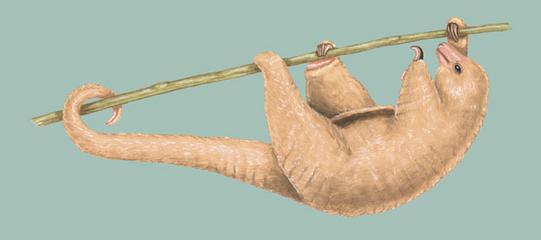Silky Anteater (Cyclopes didactylus) - Wiki Silky Anteater
From Wikipedia, the free encyclopedia
[Photo] An illustration of a silky anteater.
Silky Anteater or Pygmy Anteater (Cyclopes didactylus) is a species of anteater from Central and South America ranging from extreme southern Mexico south to Brazil and, possibly, Paraguay. It is the only species in the Cyclopes genus and the Cyclopedidae family.
It is the smallest member of the anteaters, with total length ranging from 360 to 450 mm and usually weighing less than 400 g. It has a dense and soft golden brown fur, short snout, prehensile tail and two very enlarged claws in each forepaw.
Natural history
It is a nocturnal and arboreal animal, found in lowland rainforests with continuous canopy where they can move to different places without the need to descend from trees. It can occur at fairly high densities of 0.77 individuals/ha, for example, in some areas. Females have smaller home ranges than males.
The Silky Anteater is a slow moving animal and feeds mainly on ants, between 100 to 8000 a day. Sometimes it can also feed on other insects too, such as termites and small coccinellid beatles. It is reported to defecate only once a day. Some of those feces, examined by scientists, showed a large quantity of exoskeleton fragments of insects, indicating that the Silky Anteater does not possess either chitinase or chitobiase, digestive enzymes found in insectivorous bats.
It is a solitary animal and gives birth to a single young that is usually placed inside a nest of dead leaves built in tree holes.
Some authors suggest that the Silky Anteater usually dwells in silk cotton trees (genus Ceiba). Because of its resemblance to the seed pod fibers of these trees, it can use the trees as camouflage and keep safely guarded from attacks of predators such as hawks and, especially, harpy eagles. Although they are rarely seen in the forest, it is said that they can be found easier when they are foraging on lianas at night.
When threatened, the Silky Anteater, like other anteaters, defends itself by standing on its hind legs and holding its forefeet close to its face so they can strike, with its sharp claws, any animal that tries to get closer to it.
http://en.wikipedia.org/wiki/Silky_Anteater
| The text in this page is based on the copyrighted Wikipedia article shown in above URL. It is used under the GNU Free Documentation License. You may redistribute it, verbatim or modified, providing that you comply with the terms of the GFDL. |
